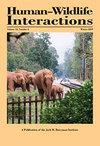Assessing Vulture Translocation as a Management Tool to Mitigate Airport Bird Strikes
IF 0.9
4区 环境科学与生态学
Q4 BIODIVERSITY CONSERVATION
引用次数: 3
Abstract
Collisions between wildlife and aircraft are a major safety concern for international aviation. In the Americas, vultures (Cathartidae) are considered to be one of the most hazardous bird species to airport operations. In this study, we evaluated the use of translocations as a management technique to reduce vulture abundance near the Manaus International Airport (MAO), Manaus, Brazil. The MAO is one of the busiest and most strategically important airports in South America, often referred to as the gateway to the Brazilian Amazon. We captured, wing-tagged, and translocated 98 vultures between August and October 2013 and between January and April 2014. The wing-tags were colored plastic tags specifically developed to tag vultures to enhance identification in flight and not alter bird behavior. The tagged vultures were translocated different distances (100, 150, and 200 km) from MAO. Only 25.5% of translocated vultures returned to the airport. However, the relative abundance of vultures did not differ between monitoring periods before and after captures and translocations. Our results demonstrated that the translocations failed to decrease MAO vulture abundance. We recommend habitat modifications associated with nonlethal (dispersion by bird repellents) and lethal (kill some individuals reinforcing dispersion) strategies to reduce vulture bird strike risks.评估秃鹫迁移作为减少机场鸟击的管理工具
野生动物与飞机之间的碰撞是国际航空的一个主要安全问题。在美洲,秃鹫(Cathartidae)被认为是机场运营中最危险的鸟类之一。毛奥机场是南美洲最繁忙、最具战略重要性的机场之一,通常被称为通往巴西亚马逊的门户。在2013年8月至10月和2014年1月至4月期间,我们捕获了98只秃鹫,并对其进行了翅膀标记和转移。翅膀上的标签是彩色的塑料标签,专门用于标记秃鹫,以提高飞行中的识别能力,而不会改变鸟类的行为。只有25.5%的被转移的秃鹫返回机场。然而,在捕获和迁移之前和之后的监测期间,秃鹫的相对丰度没有差异。我们的研究结果表明,易位并没有减少毛秃鹰的丰度。我们建议将栖息地改造与非致死性(用驱虫剂分散)和致死性(杀死一些个体加强分散)策略相结合,以降低秃鹫鸟袭击风险。
本文章由计算机程序翻译,如有差异,请以英文原文为准。
求助全文
约1分钟内获得全文
求助全文
来源期刊

Human–Wildlife Interactions
Environmental Science-Nature and Landscape Conservation
CiteScore
2.80
自引率
0.00%
发文量
0
审稿时长
11 weeks
期刊介绍:
Human–Wildlife Interactions (HWI) serves the professional needs of the wildlife biologist and manager in the arena of human–wildlife conflicts/interactions, wildlife damage management, and contemporary wildlife management. The intent of HWI is to publish original contributions on all aspects of contemporary wildlife management and human–wildlife interactions with an emphasis on scientific research and management case studies that identify and report innovative conservation strategies, technologies, tools, and partnerships that can enhance human–wildlife interactions by mitigating human–wildlife conflicts through direct and indirect management of wildlife and increased stakeholder engagement. Our intent is to promote a dialogue among wildlife professionals concerning contemporary management issues. As such, we hope to provide a repository for wildlife management science and case studies that document and share manager experiences and lessons learned.
 求助内容:
求助内容: 应助结果提醒方式:
应助结果提醒方式:


